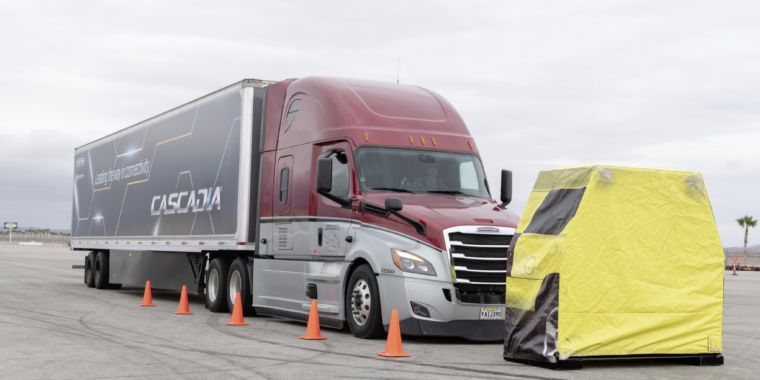
-
Daimler and Freightliner demonstrated their new advanced driver assistance systems for class 8 trucks at CES this year.
-
In repeated demos, this is as close as the truck got to the stationary “car.”Jonathan Gitlin
-
When 80,000lbs of truck and trailer makes an emergency stop from 40mph, you feel it!Jonathan Gitlin
-
The big black box coming down at the top of the windscreen is where the Cascadia’s forward-looking ADAS cameras are mounted.Jonathan Gitlin
-
The orange light is the blind spot monitor alert. Alerts also show up on the main instrument display, and there’s a loud audio alert, too.Jonathan Gitlin
-
An option for MY2020 Cascadias is this dual-screen dashboard. The smaller screen is actually a removable tablet.Jonathan Gitlin
-
Daimler and Freightliner are developing this, the eCascadia electric truck. We got a quick ride in it, which revealed the cabin was a quieter place to be without the noise and vibration of a massive Diesel engine up front.Jonathan Gitlin
-
Daimler also had this electric schoolbus (powered by Proterra) on display and doing demos.Jonathan Gitlin
LAS VEGAS—For obvious reasons, the automotive coverage at Ars often focuses on ADAS—advanced driver assistance systems. From convenience features like adaptive cruise control and lane keeping to more safety-oriented features like blind spot monitoring or automatic emergency braking, ADAS are becoming more common in new vehicles—usually with brand-specific and potentially confusing names. When the features are implemented well, they can be incredibly useful; I’ve found that rear cross-traffic alerts regularly come in handy when reversing out of a space in a crowded parking lot. Which is why I was very surprised to find out that these kinds of systems are only now just being rolled out to the biggest, heaviest vehicles on our roads: class 8 semi-trailer trucks.
As we’ve remarked (or complained about) on more than one occasion, the annual CES trade show in January has effectively turned into an auto show, with OEMs and their suppliers demoing their latest tech advances. And Daimler’s truck brand, Freightliner, is part of that crowd. In 2015, it used the Hoover Dam to show off an autonomous truck concept, and this year it returned with the production version. Called “Detroit Assist 5.0,” it features many of the same assists you might find in a current Mercedes-Benz passenger vehicle: adaptive cruise control down to zero mph, lane-keeping assistance, automatic emergency braking, and even blind spot monitoring that keeps a virtual eye on the passenger-side length of the trailer as well.
Although Volvo (for instance) has offered automatic emergency braking on its biggest trucks for some years now, Daimler says that the model year 2020 Freightliner Cascadia is the first US class 8 truck to offer a full ADAS suite and is first to market with trailer-length blind spot monitoring and lane keeping.
The view from the cockpit
The systems work in the same way as you’d expect on a light passenger vehicle, fusing together sensor inputs from radar and cameras. There has been a lot of adaptation to get them to work in this new environment: a fully loaded truck and trailer weighing 80,000lbs (36,288kg) will behave differently than even the heaviest, most roly-poly SUV. Still, it’s somewhat awe-inspiring to see a fully loaded rig barrel towards a stationary obstacle at 40mph, then come to a complete halt in less distance than you’d think possible without hitting it. Experiencing the same demo from inside the cab was even more illuminating, as well as more violent!
I was also quite impressed with the lane keeping implementation—unlike in any passenger car equivalent we’ve tried, the driver can actually fine tune where they want to center within the lane markings. (In other words, you can pick if you want to be closer to one or the other lane divider.)
Daimler Trucks North America’s general manager for marketing and strategy, Kary Schaefer, says that the systems will have positive safety benefits and pointed to a 72-percent reduction in rear-end collisions with the automatic braking assist. (ABA is also claimed to reduce serious driver injuries by 78 percent and fatalities by 82 percent.) The safety benefits of lane departure protection are more modest, but even this system is touted as reducing crashes by 26 percent and serious driver injuries by 20 percent.
Listing image by Daimler
https://arstechnica.com/?p=1454869

